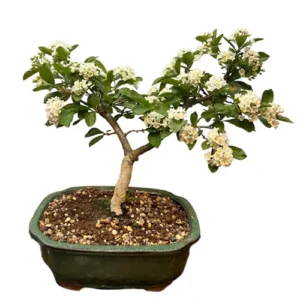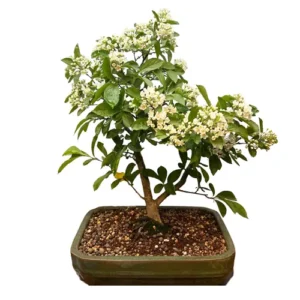Pinus thunbergii
Japanese Black Pine Bonsai
This species typically comes in an upright stately form with its long, stiff needles forming a striking display. The dark green needles shoot in pairs off craggy characterful bark announcing its presence in any garden display. Its thick dark trunk and complimenting dark foliage make this a stunning Bonsai to exhibit.
Japanese Black Pine Bonsai Care Tips
Placement
Japanese Black Pine species seek full sunlight and can withstand temperatures of remarkable humidity. If cultivating a Japanese Black Pine in the UK with its template climate, it is recommended that it is stored in a greenhouse. This species will not tolerate minus temperatures.
Watering
Soil moisture should be checked on a daily basis. However, watering should only take place when the soil is dying out, Japanese Black Pine are not to be kept wet. This species holds a considerable amount of water so it’s important to ensure the roots are suitably saturated with each session. Japanese Black pine watering is a balancing act between letting its soil dry appropriately and making sure the drying does not go on to affect the plant’s growth.
Feeding & Fertilising
Japanese Black Pine should be fed and fertilised every three to four weeks from spring through to early winter. It is advised that fertiliser is ceased from the middle of July to the end of August when the year is at its hottest.
Pruning & Wiring
When pruning Japanese Black Pine, be sure to pinch back its candles whenever the needles start to appear. Long shoots can be removed throughout the growing season. Overcrowded twigs and old needles can be addressed in late summer.
Japanese Black Pine is responsive to wiring across several seasons. Structural wiring is applicable in both the spring and the fall. For branch refining, the fall is the ideal time for wiring.
We recommend using wires with a thickness that matches the thickness of the branch: if the wire you choose is too thick you will damage the bark. If it is too thin, it won’t be effective.
Repotting
Repotting your tree is an important way to provide a fresh and suitable soil mix and ensure appropriate root health. Japanese Black Pine requires repotting every two to five years between early to mid-spring. Be sure the roots have enough space to take hold of the moisture provided from the repotting.
Trees that are ready for repotting will require root pruning, a suitable new pot and appropriate soil mix.
When repotting, do not cut back the root mass by a large amount, and choose a well-draining soil mix that has a neutral or slightly higher PH value of 5-6 but not over 7. We tend to use a mixture of different speciality bonsai soils on our trees. Every species is different so please contact us for free soil-mix advice or to take advantage of our repotting service.
Pinus is a colossal genus of conifer trees found throughout the northern hemisphere. Over 121 species exist and there are over 800 recognized cultivars. Among the several species cultivated for bonsai are the Japanese White Pine and Mugo Pine. As well as their beautiful trees and Christmas trees, pine is one of the world’s most valued sources of lumber.
Bonsai trees aren’t only magnificent additions to an indoor oasis, they are more than capable of standing out in any garden. Many Bonsai species are incredibly hardy and withstand nature’s colder and damper turns with aplomb making them worthwhile outdoor plants. We have an extensive library of care guides for outdoor bonsai trees. It’s not about selecting the perfect bonsai, it’s about selecting the perfect bonsai for you.
Japanese Black Pine Bonsai - Typical Queries
How to propagate Japanese Black Pine bonsai?
Pines, generally, can be propagated through seed, grafting and some species by air-layering. Japanese Black Pine should only be propagated through seedlings. The ideal window is at the opening of Spring and light sand is the best growing medium.
Do Japanese Black Pine bonsai get pests and diseases?
Japanese Black Pine bonsai can incur both pests and diseases. Aphids, caterpillars, and adelgids (in the Spring) can intrude on this bonsai. Spider mites can also appear in the Summer. Insecticide is appropriate where these pests can’t be picked off by hand.
Japanese Black Pine can also befall the fungal disease lophodermella, tip blight and pine wilt disease.
Can you keep a Japanese Black Pine bonsai indoors?
Japanese Black Pine bonsai is a hardy evergreen species that is suitable for northern temperate regions. This is not a species to give shade to and it is unadvisable to keep indoors.





















